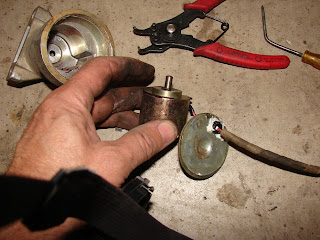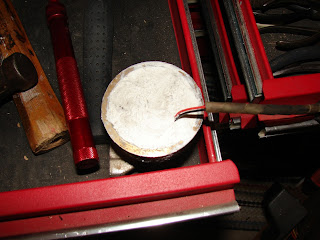A common failure on the Range Rover Classic is the high/low range shift solenoid. This system often fails and leaves your Range Rover stuck in high range.
My Classic has had it’s lever stuck this way for 5 years. And in those five years, I’ve needed low range at least once each year since it happened. The reasons are all the same, keeping myself from getting stuck. When I got stuck behind my new house in 2005, I’d like to believe if I had low range then I would not have gotten stuck. Last year during the Christmas Eve Snowpocalypse I needed the low range to help extract the my oldests kid’s Ford Explorer 4×4, some dumb kids dressed in shorts, hoodies, and flip flops (seriously) that got stuck in a snow drift at the entrance to our neighborhood, and when my friend used the LWB to pull his Jeep out of a snow drift a few days later after he got stuck trying to pull a car out.
In every example except the first, low range was not needed. I wonder if it would have mattered anyway. The Range Rover was able to pull everyone out with only the front axle, due to the failed drive shaft and busted viscous coupling. Imagine how capable the Classic would have been with both axles working correctly!
So with that a common fix is to remove the solenoid and to remove the pin that holds the lever stuck in high. I know I could have investigated all the parts that caused it to fail. But I didn’t want to spend the time to find the gremlin. It is easy enough to just disable the SAFETY DEVICE.
You must know at this point you are removing the device that prevents you from ACCIDENTALLY putting your transfer case into low range if you are exceeding any of the conditions that are installed to prevent that from happening. This shouldn’t be a problem. I know you have to basically be sitting still, in neutral before you can move the lever to low.
I lined up my tools to remove the solenoid and investigate how to disable it. I got my socket set out and a hex head bit to remove the two bolts holding the solenoid to the shifting lever.
Once again these were difficult to get broke free. The years of water and corrosion have basically welded the bolts in place. After they broke free I pulled the solenoid out and had a look at it.
That’s the pin that prevents a lever located on the bottom of the shift lever from moving “forward” to the low range. To get to the mechanism you have to remove the silicone bathroom caulk…wait what? Yeah, bathroom caulk, They filled the back side of the solenoid frame with caulk.
You can see in the picture with some of the caulk removed that the unit is not exactly water tight. I wonder how many of these failed before the factory started sealing them with bathroom caulk? I wonder which engineer got a bonus for his simple solution to this problem?
Head Engineer: “These solenoids are failing at an alarming rate from water ingression.”
Lesser Engineer: “I have an idea. Last night I was working in the loo and I was sealing the toilet at the base with caulking. How about we just fill the backside with silicone bathroom caulk. That should buy us at least three years. At that point the warranty will be void.”
Head Engineer: “Genius! Let’s head down to the pub to celebrate!”
Lesser Engineer: “But sir, it’s only 9:03 am.”
Head Engineer: “What’s your point?”
I think you get MY point. So you get the C clip pliers out and with the help of a small screw driver you remove the clip and remove the electrical bits from the casing.
All that’s left is cutting the pin off. No biggy. With the pin cut off it’s time to get it all reassembled and to have a couple of rum and cokes and a nice Arturo Fuente cigar while you wait for the bathroom caulk to set up.
Actually I did mine, got drunk and went to bed.
So why did you re-caulk it if you just destroyed it’s ability to do its job? Well I’m not exactly sure how to answer that. It seemed like the thing to do at the time. Hell, using bathroom caulk on a brand new 50,000$(US) Range Rover with Mediterranean Poplar wood accents is just redneck enough to make it into the Redneck Repair Hall of Fame.
Thanks for reading and Happy Rovering.





Hi my 1994 range rover classic is stuck in Hi and I think my solenoid is bad and I think I am going to remove it following your steps. But I was wondering if you suggest going at it from the center console or down under the car I have heard of people doing both. And if you suggest going through the center console do you have any tips or instructions on taking apart the center console? Thank you any help is much appreciated!
If you go from the console down be careful. The plastic bits on the console are getting on in age and there are no replacements available. I remember having to make parts to glue mine back together. Its been a while since I did this job and I don’t have any additional technical advice. Sorry. If I remember correctly its a pretty simple job.
Would it be the same solution if my vehicle is stuck in low instead?? Thanks for your time.
Hi believe so.